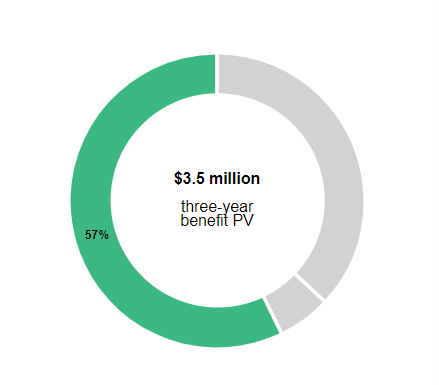If your organization is aiming to stay competitive and leverage newer technologies in the long run, now might be the ideal time to consider transitioning from a legacy ERP system, such as AX 2012, to the advanced Microsoft Dynamics 365 Finance & Supply Chain Management ERP system. Microsoft’s mainstream support for AX customers is no longer available, making this transition crucial. Moreover, you'll save on infrastructure costs, enjoy easier and faster reporting, and have a wider array of integration options.
At To-Increase, we build solutions for both AX 2012 and Dynamics 365 F&SCM, and we understand the benefits of moving to the latest version of the Dynamics 365 ERP and have also helped companies with data migration during the switch using our integration solution – Connectivity Studio for D365 F&SCM.
So, if you use AX 2012 and are hesitant to switch to Dynamics 365, we can make it easier for you. Below we share the challenges in AX 2012 and the benefits of moving to D365 F&SCM.
Challenges in AX 2012 mitigated by D365 F&SCM
Infrastructure
In AX 2012, the backend environment is highly complex involving numerous servers that your IT team has to manage. Furthermore, they would have to implement VPN, and firewalls for security, adding to the complexity. If your organization has a distributed environment across locations, it gets even more difficult to supervise since it is on-premises. Additionally, this presents challenges in facilitating a remote working environment for your teams. Since the infrastructure is complicated, scaling can be difficult and makes it a more expensive and time-consuming undertaking.
Since D365 F&SCM is available on the cloud, the infrastructure is less complicated to manage, and you save on the additional server costs, time, and resources that you would have to factor in for on-premises. Scaling up is easier; all you need is additional licenses. Additionally, your employees can also connect from anywhere.
Reporting
A lot of processes are manual, and that makes reporting difficult and complex in AX 2012. There are a few tools for reporting in AX 2012 that you can use. Management Reporter, for example, can be used with the ERP but it is another server application that IT has to manage. SSRS offers embedded reporting, but you need a developer to work on the reports and decipher their meaning. There is limited support available for OLAP cubes for advanced analytic reporting. You can also use Power BI capabilities, although they are limited for AX and can be time-consuming and costly.
Reporting for F&SCM in comparison, is quite advanced with Business documents and Electronic reporting for critical documents. The first is for customer-facing documents used to exchange business information, and the second is for configuring the formats for electronic documents. Additionally, there are self-service tools such as Operational Views and Power BI. Operational views can be used by business users to design reports for specific requirements. And Power BI can be used for advanced analytic reporting for all F&SCM modules. There is also the option of financial reporting embedded in D365 that can help you analyze financial activities across legal entities.
Support
Microsoft’s extended support for SQL Server, Windows, etc., for AX 2012 customers ended in October 2023. This also means no new upgrades or new features for the ERP system. However, it is possible that your Microsoft partner might support you. This is not the case with D365 F&SCM.
Security
Organizations have to host their hardware and software for AX in their own environment and manage security on their own, which can be a huge cost. In case of a natural disaster, such as a fire, it can be difficult to fix the damage. And to avoid ransomware and cyber-attacks on their ERP system, organizations have to factor in huge investments to stay secure. Microsoft D365 F&SCM on the other hand, has been built in Microsoft Azure and leverages the latest Azure security technologies. Also, in case of any data loss, D365 F&SCM offers disaster recovery, so you can recover data from Azure in near-real time.
Upgrades
For AX 2012, since it was an on-premises system, it was the customer’s responsibility to manually download the latest releases from Microsoft and keep their systems up to date. Although these updates were few and far between, they needed special skills and were costly and time-consuming as you needed to update each system separately.
Since D365 F&SCM is a software-as-a-service model, service updates are continuous. Additionally, you can pause updates, and test the new features before you upgrade. So, if you decide to invest in ISV solutions, such as our data governance solutions — Master Data Management Suite for D365 F&SCM, for example, you can pause your upgrade, implement our solutions, and then start the update from Microsoft.
However, D365 offers a plethora of options. Using 'Dual Write' for Power platforms, you can exchange data with other native apps such as sales, and field service, and so on. You can also use oData to connect with external systems, and Azure API services help you connect with web services, customized API, or batch APIs. Moreover, D365 F&SCM offers Office integrations with Excel that allow business users to export data to Excel whenever required.
Benefits of moving to Dynamics 365 F&SCM
Moving to D365 F&SCM is undoubtedly a mammoth project. But the benefits of moving far outweigh the costs you will incur if you decide to continue using AX 2012. Microsoft commissioned the Total Economic Impact™ Study (TEI) to Forrester last year. For this study, Forrester interviewed four experts at organizations using D365 Finance to analyze the investment's impact on cost, flexibility, benefits, and risk. Below, we summarize some of the benefits listed in the report.
Standardization of processes
Based on the report, interviewees using legacy ERPs spent a significant amount of resources, time, and effort creating financial reports that were no longer relevant by the time they reached their stakeholders. Standardization across teams and regions was nearly impossible. However, by utilizing Dynamics 365 Finance, organizations were able to standardize financial processes across legal entities and use data for decision-making, leading to a reduction in external hires.
Standardizing Dynamics 365 Finance also greatly improved the time and effort spent on month-end tasks. The process, which previously took 20+ days using legacy systems, was streamlined to almost six days using D365. Consequently, the processes and experience for the organization’s finance staff were significantly enhanced.
Improved Productivity
The ease of use and reduction in manual processes resulted in increased productivity and resource optimization. Dynamics 365 Finance's expense management functionality streamlined requests for staff at retail locations, eliminating the need for manual scanning and uploading of documents. Additionally, the ERP offers role-based workspaces and personalized dashboards.
Automated Processes
According to the study, the organization was able to 'completely automate its procurement processes, wholesale customer invoicing, and customer payments.' Using the legacy ERP required a significant amount of manual work, leading to delays and negative customer experiences, all of which were resolved upon the implementation of D365.
Simpler Infrastructure
All the organizations interviewed for the study transitioned from on-premises ERP systems to cloud-based D365. Each of these organizations admitted that their IT teams had to invest significant time and effort in managing the on-premises infrastructure. Moreover, to access exclusive functionalities, the organizations had to hire expensive and scarce developers, making scaling a daunting challenge.
Dynamics 365 Finance offered an easier-to-maintain solution with superior functionality and fewer required customizations, saving the organizations valuable time. This reduced their dependency on IT staff and allowed them to focus on more crucial tasks, such as data governance, for example.
Reduced Costs
With legacy systems, organizations had to spend on maintaining their own infrastructure, additional resources to manage the ERP system, and the costs associated with customizations. Using D365 F&SCM, these expenses were drastically reduced. According to the study, organizations were also able to save in the following ways:
- On solutions such as an external timesheet solution, saving the organization more than $100,000 annually.
- By reducing their spending on solutions such as an external auditing service.
- On expansion, as Dynamics 365 in the cloud offers real-time scaling based on business requirements.

The benefits witnessed over a 3-year period by the organizations interviewed for the Total Economic Impact™ Of Microsoft Dynamics 365 Finance (Source).
Real-time data for improved decision-making
Dynamics 365 offers real-time financial data, making it easier to make decisions that can enhance revenue and reporting. Additionally, organizations found a clearer understanding of their sales channels within Dynamics 365, enabling them to forecast orders and plan ahead for their top customers.
Improved compliance
D365 offers simpler regulatory compliance processes and the participants agreed that this has saved them time and expenses, especially while expanding to different areas that may have different compliance guidelines.
Additional benefits of moving to Dynamics 365 F&SCM ERP
Let’s look at some of the additional benefits that you can expect after moving to D365 F&SCM.
Improved user experience: The ERP offers a user-friendly interface and easier navigation, which provides a better customer experience.
Leverage Microsoft technologies: Using D365, you can take advantages of newer technologies such as Power apps, Power Automate, Office 365, and Azure services with minimal development.
Updates and customizations: Updates are easily applied with minimal impact using Microsoft’s 'Evergreen approach'. And customizations are implemented as extensions to core functionality so that reduces the impact on core functionality.
Reduced infrastructure cost and effort: The production environment and all other environments including testing, staging, and development are hosted on the cloud which is managed by Microsoft.
Improved security: Microsoft is investing 1 billion in Azure security and leveraging the latest technologies and expertise. It is difficult to compete with that.
Offers industry-specific functionality: D365 F&SCM offers industry-specific functionality out of the box. For example, the solution supports product lifecycle management for the manufacturing industry, inventory management for the retail industry, warehousing management for the logistics industry, and many other functionalities that can be customized for other industries.
AI & machine learning capabilities: Microsoft has been testing the waters with Microsoft Co-pilot for AI and machine learning and is continuously upgrading functionalities using these advanced technologies. Some of the AI and machine learning based functionalities that Microsoft offers are intelligent insights based on historical data, demand forecasting based on sales history, trends and other available information, predictive maintenance for equipment and machinery.
IoT integration and automation: IoT integration and automation can help streamline operations, optimize processes, improve asset management, and help you make better decisions. An example would be integrating IoT devices such as sensors with Dynamics 365 F&SCM to track goods in the supply chain. The same can be done for equipment and that can help you understand the need for equipment maintenance. There are several other IoT devices such as barcode scanners and RFID readers that can be used to improve operations and decision making while tracking goods.
Are you considering moving to Dynamics 365?
Moving to D365 F&SCM from any legacy system can help future-proof your business.
Imagine a future where you can accelerate operations, scale without additional infrastructure costs, and save time and effort. You can also reduce expenses related to resources, time, infrastructure, development, and maintenance. Additionally, with Microsoft’s focus on AI and cybersecurity, you can enjoy the privilege of the latest innovations and improved security. The ease of use and flexibility of the solution mean happier employees and improved productivity. Furthermore, in our post-Covid-19 world, having remote access is another advantage.
If you have made up your mind about moving to D365 F&SCM, and are worried about the enormous migration project, don’t be. We admit there will be challenges in your path, but we can help. To understand what challenges to expect in data migration and how you can solve them, read our blog by clicking on the link below.





